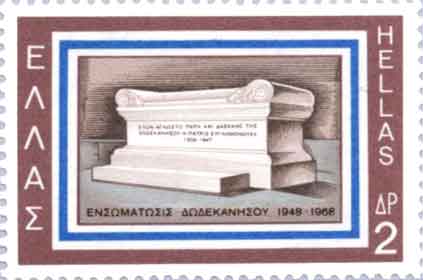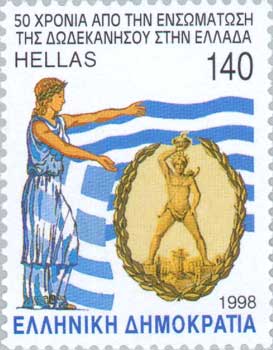.
Periphery: South Aegean
Prefectures : Cyclades, Dodecanese
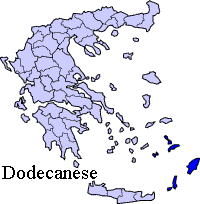
The Dodecanese (Greek: Δωδεκάνησα, Dodekánisa, meaning "twelve islands") are a group of Greek islands in the Aegean Sea, off the southwest coast of Turkey. They have a rich history, and many of even the smallest inhabited islands boast dozens of Byzantine churches and medieval castles.
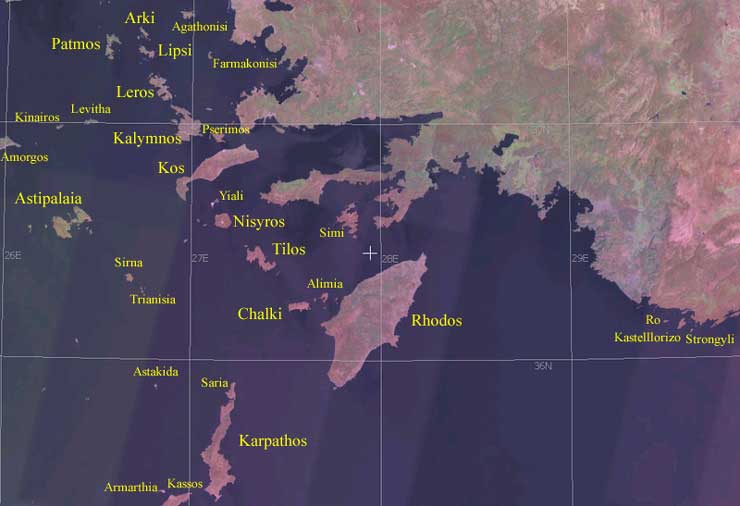
Map, select island
| Dodecanese Prefecture ομόςΔωδεκανήσων |
|
|---|---|
| Periphery | South Aegean |
| Capital | Rhodes |
| Population | 200,452 (2005) Ranked 10th |
| Area | 2,714 km² Ranked 19th |
| Population density | 73.9/km² Ranked 11th |
| Number of municipalities | 25 |
| Number of communities | 2 |
| Postal codes | 85x xx |
| Area codes | 224x0 |
| Licence plate code | ΚΧ |
| ISO 3166-2 code | GR-81 |
| Website | |
The current Greek administrative region of the Dodecanese (a subdivision of the South Aegean periphery) consists of 163 total islands of which 26 are inhabited. Twelve of these are major, giving the chain its name. The most historically important and well-known is Rhodes (Rodos), which for millennia has been the island from which the region is controlled. Of the others, Kos is the historically most important; the remaining ten are Astipalea, Kalimnos, Karpathos, Kassos, Kastellorizo, Leros, Nisyros, Patmos, Simi, and Tilos.
Other notable islands in the chain include Agathonissi, Halki, Lipsi, Pserimos, and Telendos.
History
The Dodecanese have been inhabited since prehistoric times. In the oldest historic period, they formed part of the Minoan civilization for several millennia. Following the downfall of the Minoans, the islands were ruled by the Achaeans from circa 1400 BC, until the arrival of the Dorians circa 1100 BC. It is in the Dorian period that they began to prosper as an independent entity, developing a thriving economy and culture through the following centuries. By the early Archaic period Rhodes and Kos emerged as the major islands in the group, and in the 6th century BC the Dorians founded three major cities on Rhodes (Lindos, Kameiros and Ialyssos); together with the island of Kos and the cities of Knidos and Halicarnassos on the mainland of Asian Minor, these made up the Dorian Hexapolis.
This development was interrupted around 499 BC by the Persian Wars, during which the islands were captured by the Persians for a brief period. Following the defeat of the Persians by the Athenians in 478 BC, the cities joined the Athenian-dominated Delian League. When the Peloponnesian War broke out in 431 BC, they remained largely neutral although they were still members of the League.
By the time the Peloponnesian War ended in 404 BC, the Dodecanese were largely removed from the larger Aegean conflicts, and had begun a period of relative quiet and prosperity. In 408 BC the three cities of Rhodes had united to form one state, which built a new capital on the northern end of the island, also named Rhodes; this united Rhodes was to dominate the region for the coming millennia. Other islands in the Dodecanese also developed into significant economic and cultural centers; most notably, Kos served as the site of the school of medicine founded by Hippocrates.
However, the Peloponnesian War had so weakened the entire Greek civilization's military strength that it lay open to invasion. In 357 BC the islands were conquered by Mausolus of Halicarnassus, then in 340 BC by the Persians. But this second period of Persian rule proved to be nearly as short as the first, and the islands became part of the rapidly growing Macedonian Empire as Alexander the Great swept through and defeated the Persians in 322 BC, to the great relief of the islands' inhabitants.
Following the death of Alexander, the islands, and even Rhodes itself, were split up among the many generals who contended to succeed him. The islands formed strong commercial ties with the Ptolemies in Egypt, and together they formed the Rhodo-Egyptian alliance which controlled trade throughout the Aegean in the 3rd century BC. Led by Rhodes, the islands developed into maritime, commercial and cultural centers: coins of Rhodes circulated almost everywhere in the Mediterranean, and the islands' schools of philosophy, literature and rhetoric were famous. The Colossus of Rhodes, built in 304 BC, perhaps best symbolized their wealth and power.
In 164 BC, Rhodes signed a treaty with Rome, and the islands became aligned to greater or lesser extents with the Roman Empire while mostly maintaining their autonomy. Rhodes quickly became a major schooling center for Roman noble families, and, as the islands (and particularly Rhodes) were important allies of Rome, they enjoyed numerous privileges and generally friendly relations. These were eventually lost in 42 BC, in the turmoil following the assassination of Julius Caesar in 44 BC, after which Cassius invaded and sacked the islands. Thereafter they became part of the Roman Empire proper, and eventually were joined with Crete as part of the 18th Province of the Roman Empire.
In the 1st century, Saint Paul visited the islands twice, and Saint John visited numerous times; they succeeded in converting the islands to Christianity, placing them among the first dominantly Christian regions. Saint John eventually came to reside among them, being exiled to Patmos, where he wrote his famous Revelation.
As the Roman Empire split into Eastern (Byzantine) and Western (Roman) halves, the islands became part of the Greek-speaking Byzantine Empire. They would remain there for nearly a thousand years, though these were punctuated by numerous invasions. It was during this period that they began to re-emerge as an independent entity, and the term Dodecanese itself dates to around the 8th century. Copious evidence of the Byzantine period remains on the islands today, most notably in hundreds of churches from the period which can be seen in various states of preservation.
In the 13th century, Italians began invading portions of the Dodecanese; Venetians and Genoese each held some islands for brief periods. Finally, in the 14th century, the Byzantine era came to an end when the islands were taken by forces of the Knights Hospitaller (Knights of St. John): Rhodes was conquered in 1309, and the rest of the islands fell gradually over the next few decades. The Knights made Rhodes their stronghold, transforming its capital into a grandiose medieval city dominated by an impressive fortress, and scattered fortresses and citadels through the rest of the islands as well.
These massive fortifications proved sufficient to repel invasions by the Sultan of Egypt in 1444 and Mehmed II in 1480. Finally, however, the citadel at Rhodes fell to the large army of Suleiman the Magnificent in 1522, and the other islands were overrun within the year. The few remaining Knights fled to Malta.
Thus began a period of several hundred years in the Ottoman Empire. The islands were allowed to retain a number of privileges provided they submitted to Ottoman rule. By Suleiman's edict, they paid a special tax in return for a special autonomous status that prohibited Ottoman generals from interfering in their civil affairs or mistreating the population. These guarantees, combined with a strategic location at the crossroads of Mediterranean shipping, allowed the islands to prosper. Although sympathies of the overwhemingly-Greek population leaned heavily towards Greece following its declaration of independence in 1822, the islanders did not join the Greek War of Independence, continuing instead a semi-autonomous existence as an archipelago of Greek merchants within the Ottoman Empire. Indeed, the 19th century turned out to be one of the islands' most prosperous, and a number of mansions date from this era.
Against the backdrop of the First Balkan War (which pitted Greece against Turkey) and a simultaneous Italian-Turkish war over nearby Libya, the islands finally declared independence from the Ottoman Empire in 1912, proclaiming an independent state as the Federation of the Dodecanese Islands. This nascent state was quashed almost immediately by the invasion of Italy, which wanted the islands, and particularly the fortress of Rhodes, to control the Mediterranean.
Italy established a military protectorate over the islands headquartered at Rhodes, and formed them into the province of Rodi. Following the entrance of Italy into World War I on the side of France and Britain in 1915, the islands became an important British and French naval base, used as a staging area for numerous campaigns, most famously the one at Gallipoli. During the war some of the smaller islands were occupied by the French and British, with Rhodes continuing as Italian-occupied.
Following the war, the Treaty of Sevres in 1919 called for most of the smaller islands to join with Greece, with Rhodes and several other islands remaining Italian. Italy, however, occupied all the islands, including those from which the French and British had now withdrawn; the Treaty of Lausanne in 1923 gave international recognition to the continued Italian administration.
The rise to power of Benito Mussolini and his Fascist Party in 1922 led to a period of repressive rule. Mussolini embarked on a program of Italianization, hoping to make Rhodes a modern transportation hub that would serve as a focal point for the spread of Italian culture through a planned Mediterranean empire. Although the islands were overwhelmingly Greek-speaking, punctuated only by a relatively small Turkish-speaking minority and even smaller Ladino-speaking Jewish minority (with virtually no Italian speakers), schools were required to teach in Italian, and the Greek Orthodox religion of most of the inhabitants was strongly discouraged. These measures caused a good deal of Greek emigration from the island, replaced by a moderate (but relatively small) amount of Italian immigration. Despite this, the Fascist program did have some positive effects in its attempts to modernize the islands, resulting in the eradication of malaria, and the construction of hospitals, aqueducts, and a power plant to provide Rhodes' capital with electric lighting. However, the concrete-dominated Fascist architectural style detracted significantly from the islands' picturesque scenery (and also reminded the inhabitants of Italian rule), and has consequently been largely demolished or remodeled.
|
Dodecanese 1948 Union Monument: "To the unknown priest and teacher of Dodecanese, thanks from the fatherland" |
1998, 50 years after the union (the Colossus of Rhodes) |
During World War II, Italy joined the Axis Powers, and used the Dodecanese as a naval staging area for its invasion of Crete in 1940. In 1943 the islands came under German occupation, and, although the Germans were driven out of mainland Greece in 1944, they remained occupied by Germany until the end of the war in 1945.
Following the war, the islands became a British military protectorate, and were almost immediately allowed to run their own civil affairs, upon which the islands became informally united with Greece, though under separate sovereignty and military control. Despite objections from Turkey, which desired the islands as well, they were formally united with Greece by the 1947 Peace Treaty with Italy.
Today Rhodes and the Dodecanese are favorite travel destinations. The Old City of Rhodes, repaired and functioning as a living community behind its medieval walls, is particularly interesting.
Municipalities and communities
| Municipality | YPES code | Seat | Postal code | Area code |
|---|---|---|---|---|
| Afantou | 1205 | Afantou | 851 03 | 22410-5 |
| Archangelos | 1202 | Archangelos | 851 02 | 22440-2 |
| Astypalaia | 1203 | Astypalaia | 859 00 | 22430-4 |
| Attavyros | 1204 | Empona | 851 09 | 22460-5 |
| Chalki | 1227 | Chalki | 851 10 | 22410-4 |
| Dikaio | 1206 | Dikaio | 853 00 | |
| Ialysos | 1208 | Ialysos | 851 01 | 22410-9 |
| Irakleides | 1207 | Antimachia | 853 02 | 22420-6 |
| Kallithea | 1209 | Faliraki | 851 05 | 22410-6 |
| Kalymnos | 1210 | Kálimnos | 852 00 | 22430-2 |
| Kameiros | 1211 | Soroni | 851 06 | 22460-4 |
| Karpathos | 1212 | Kárpathos | 858 00 | 22-2 |
| Kasos | 1213 | Kasos | 857 00 | 22450-4 |
| Kos | 1214 | Kós | 853 00 | 22450-2 |
| Leipsoi | 1215 | Leipsoi | 850 01 | 22470-4 |
| Leros | 1216 | Léros | 854 00 | 22470 |
| Lindos | 1217 | Lindos | 851 07 | 22440 |
| Megisti | 1218 | Megisti | 851 11 | 22410-49 |
| Nisyros | 1219 | Nísiros | 853 03 | 22420 |
| Patmos | 1222 | Pátmos | 855 00 | 22470 |
| Petaloudes | 1223 | Kremasti | 851 04 | 22410 |
| Rhodes | 1224 | Rhodes | 851 00 | 22410-2 thru 7 |
| Symi | 1225 | Symi | 856 00 | 22460 |
| Tilos | 1226 | Tilos | 850 02 | 22460 |
| Community | YPES code | Seat | Postal code | Area code |
| Agathonisi | 1201 | |||
| Olympos | 1221 |
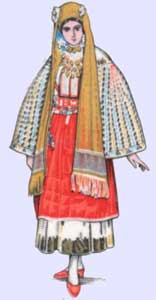
Nisyros, Traditional Fashion
- Agathonisi
- Arkoi
- Astakida
- Attavyros
- Fournoi
- Ikaria
- Kálimnos
- Kastellórizo
- Chalki (or Halki or Khalki)
- Kinaros
- Levitha
- Ofidoussa
- Ro
- Samos
- Saria
- Syrna
- Zafora
| Ancient Greece
Science, Technology , Medicine , Warfare, , Biographies , Life , Cities/Places/Maps , Arts , Literature , Philosophy ,Olympics, Mythology , History , Images Medieval Greece / Byzantine Empire Science, Technology, Arts, , Warfare , Literature, Biographies, Icons, History Modern Greece Cities, Islands, Regions, Fauna/Flora ,Biographies , History , Warfare, Science/Technology, Literature, Music , Arts , Film/Actors , Sport , Fashion --- |
Retrieved from "http://en.wikipedia.org/"
All text is available under the terms of the GNU Free Documentation License


